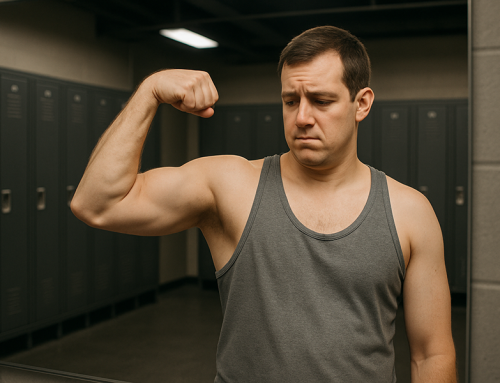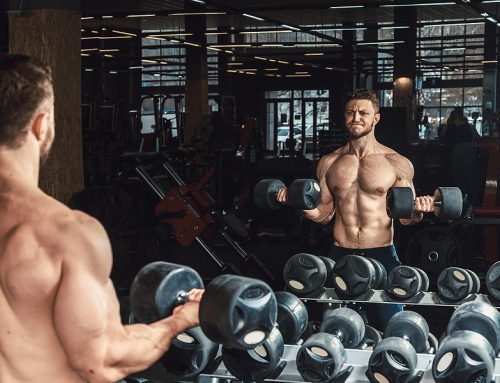How do you make your muscles grow? That’s easy! All you have to do is lift more weight every time you go into the gym. Everyone knows that. Just keep getting stronger! If you gradually lift more weight, that’s called progressive overload and that’s the trigger to gain more muscle, right? Well, not exactly. The truth is, you really can gain muscle without lifting heavy.

Granted, increasing the weight you lift is one way to overload your muscles. It’s the most well-known way, and it’s especially important in the early stages of your training evolution, when you’re young, healthy and have lots of room for improvement.
The problem is, what happens when you can’t increase the weight anymore? “Just lift more weight” every workout sounds good in theory, but in reality, you can’t increase the weight all the time.
Maybe as a beginner, you’ll add weight at every workout for weeks or even months, (those are the “newbie gains”), but at some point, everyone reaches a progress plateau where the weight gets stuck.
Even when you break through those plateaus, which can be accomplished with good programming and persistence, you get a little bit stronger, but then you hit more plateaus and you hit plateaus more often. Ultimately, there’s a limit to how much weight you can lift. You can’t keep getting stronger forever. What then?
Even if you manage to get a little stronger every year for decades – through your 20’s and 30’s or even your 40’s, at a certain age, you reach your athletic peak. When you pass that point, as you get older, it gets harder than ever to lift more weight, and eventually, your strength levels start to slowly decline as a part of normal aging. What then?
And what if, even when you’ve still got your youthful strength, you have an injury or tendinitis or a bad shoulder or low back pain? You can lift, but every time you try to lift heavier, the pain gets worse. If you try to push through it, it knocks you out of commission and you can’t lift at all. What then?
Every time you can safely increase the weight, you should, but “just lift more weight” is easier said than done. Adding weight to the bar is a very slow process and there are limitations to how far you can go using this type of overload alone.
If your only focus is lifting more, then every time you’re stuck at a strength plateau, or you’re unable to lift more for any reason, you’ll become frustrated, exasperated, even despondent. You might believe you’ve maxed out your genetic potential and are unable to make more progress. You may think you have to settle for just maintaining the body you have now. You might wonder if you’re wasting your time in the gym and even feel like giving up.
There are three problems that lead most lifters to this depressing and discouraging place, but fortunately, there are also solutions.
The first problem is that most people have been brainwashed into believing that the only way to gain muscle is to increase the weight you lift. This is not true, yet this myth has been spread for years, often by trainers who only have backgrounds in strength sports, not physique sports.
The goal in physique training is not strength per se – it is transforming your body’s appearance. That’s what the average guy or gal wants as well. Most people may not be training to get onstage, but they do want to look great in a swimsuit. When you consider the principle of training specificity, you understand that always lifting more weight is not as high a priority for muscle building as it is for strength sports.
It’s true that if you get stronger, you’ll usually gain muscle as well. However, what you must understand is that lifting more is not the only way to gain muscle. The real secret to gaining muscle is using the progressive overload principle.
That leads us to the second problem: most people don’t even know the difference between progressive resistance and progressive overload. They are not the same thing! Progressive resistance is lifting more weight. Progressive overload is any kind of increase in workload that your body has not performed before.
There are at least 8 types of progressive overload, and lifting more weight is only one of them. Yes, you can gain muscle without lifting heavy.
The third problem, which leaves multitudes of muscle-seekers in perpetual disappointment with their lack of progress or inability to train around injuries, is that most people don’t know about or properly use the other 7 progressive overload techniques. These techniques are overlooked, under-appreciated or neglected.
Finally, you’re now about to learn how to use all these overload techniques to gain more muscle without lifting more weight. But first, a let’s do a quick recap of the progressive resistance technique.
Increase the weight (Progressive resistance)
Make no mistake, progressive resistance is a vital strategy for building muscle. Increasing how much weight you lift is widely accepted as the most effective type of overload – that’s the goal you strive for first. When you can’t lift more weight, then you use the other overload methods to keep progressing in some other way.
Progressive resistance simply means adding weight to the bar (or lifting the next heavier set of dumbbells, using the next plate on the weight stack, and so on), whenever you are able to. If you do the same number of reps you did before with a heavier weight, with the same good form, you have overloaded your muscles, and provided all the other factors necessary for growth are in place, your muscle development will increase.
As we’ve discussed, you won’t be able to increase the weight you lift at every workout, and the more years you’ve been training, the slower the increases happen. That’s when the other 7 progressive overload techniques are especially useful.
1. Do more reps with the same weight.
One way to gain muscle without lifting heavy is to simply keep the reps the same and overload by doing more reps.
All it takes is one more rep in perfect form with the same weight and you have increased the volume of the workout and successfully applied progressive overload. For example, if you did 8 reps with 200 pounds for 3 sets, the total amount lifted (“tonnage” or volume) is 4,800 pounds (200 X 8 X 3). If you add a rep each workout and build up to 9, 10, 11 and then 12 reps, over those 5 workouts, you’ve increased the volume to 7,200 pounds. Is that an overload? You bet it is.
Two of the major benefits of increasing reps is that with a little effort, you can almost always do one more rep somewhere in your workout, and making progress at every workout keeps you highly motivated. Furthermore, working into higher rep ranges is more joint friendly than traditional heavy-load strength training which is typically done in the 4 to 6 rep range. Sets of 5, for example, are well known as optimal for building strength, but what if your primary goal is building muscle, not strength?
It’s generally accepted that the ideal rep range for building muscle is 8 to 12 (some say 6 to 12) reps and you should concentrate your training in this zone. However, the most recent research suggests that using a variety of rep ranges is optimal for building muscle. This would include the strength zone (low reps, heavy weight), the hypertrophy zone (medium reps, medium weight) and the metabolic zone (high reps, light weight).
Anyone who struggles with joint pain when training in the low rep, heavy weight zone will be happy to hear that you can also get great muscle gains working in the hypertrophy and metabolic zones. New studies published in the Journal of Strength and Conditioning Research found that high repetitions in the 15 to 20 and even 25 to 30 range produced muscle growth when the sets were worked hard, to fatigue.
It would not be ideal to do high reps exclusively, unless absolutely necessary, but the important thing for making gains is progression, and increasing the reps at the same weight, regardless of the rep range, is a simple, proven way to do it.
2. Increase the number of sets with the same weight and reps.
There is always the possibility that you won’t be able to increase either the weight or the reps. For advanced trainees, it gets harder to continue adding weight, adding reps and gaining more muscle than it is for beginners. This is where the advanced lifter starts using other overload strategies to continue making more muscle gains.
One of these methods is doing more sets. If you were doing 3 sets with 200 pounds for 10 reps and you increase that to 4 sets with 200 pounds for 10 reps, you have increased your volume from 6,000 pounds to 8,000 pounds. Is that an overload? You bet!
Volume is directly correlated to muscle growth, up to a point, so any increase in volume whether that is more reps, more sets, more exercises, or a combination of the three, can potentially increase muscle growth if it’s more than you were doing before.
A downside is that adding sets makes your workouts longer, so it’s not ideal for busy people. You also can’t increase sets indefinitely – there’s a point of diminishing returns, and ultimately a point of overtraining.
However, if your current program is only using a low or moderate volume and you’re stuck on the weight and or reps, progressive overload is as simple as adding one more set. Plus, many coaches believe this is the most effective way to gain muscle without lifting heavy.
3. Increase the number of exercises.
Adding more exercises is another way to increase the volume. For example, 4 sets of 10 reps on the bench press with 200 pounds is 8,000 pounds lifted. Suppose your bench press is stuck at 200 pounds for 10 reps, but you add a second exercise, the incline dumbbell press. If you use 60 pound dumbbells for 3 sets of 10 reps, that’s another 1,800 pounds for a total of 9,800 pounds. Is that an overload? It sure is.
Of course, adding exercises has some of the same pros and cons of adding sets. You can’t keep adding exercises forever, because you’ll eventually reach an overtraining point. Plus, your workouts will take longer, so if time-efficiency is a priority, you might want to use the other methods of overload down on this list.
4. Lift the same weight more often.
Based on the latest research, many bodybuilders have started increasing their weekly training frequency above the old popular method of once per week per muscle growth. Some are training each muscle once every 4 to 6 days, some have jumped to working each muscle twice a week.
Some of the studies which has prompted people to lift more often were based on the protein synthesis theory. Yet it’s also worth considering that increasing your training frequency is another method of progressive overload. Many lifters have focused so much on just increasing weight, they have completely overlooked this obvious option.
If you leave your entire workout the same – same exercises, sets, reps and weight, but you change your split or your weekly training schedule so that each muscle is worked more often, you will usually see a substantial increase in muscle growth from that simple change alone.
As with increasing sets and exercises, this method has some limits. In most cases, it requires more workouts each week, yet being in the gym 6 days or even 5 days a week is not practical for everyone. The workouts can also get very long if you try to keep the same volume, and longer workouts may not be practical for some people.
5. Lift with better form and mind to muscle connection.
An excessive focus on strength often creates an obsession with always lifting heavier, even when you’re not ready, and that in turn leads to compromising form – a major muscle-building mistake.
You might think you’ve been successful in your training by adding more weight to the bar, but if you cheated on form, no true progression has taken place. It’s fake progression – ego lifting. Cheating usually decreases tension on the target muscle and increases the risk of injury or joint pain.
At a certain point, once a base of strength and muscle size has been built, many advanced bodybuilders put less emphasis on increasing the pounds lifted as their primary progression strategy and more attention on improving their form. Their goal is to increase repetition quality and increase muscle tension through a stronger mind to muscle connection.
Both psychologists and exercise physiologists have studied this subject in depth and demonstrated that “attentional focus” (mind to muscle connection) can increase muscle activation.
Although we may not be able to quantify repetition quality as easily as we can track the weights, sets, reps, volume and frequency, increasing your repetition quality can absolutely be considered another method of overload.
Moreover, this is a vitally important strategy for advanced physique athletes, older lifters and anyone with joint pain that prevents maximally heavy lifting (because the focus goes more on quality of reps than quantity of weight).
6. Perform more work in less time.
In weight training, the word density means how much work you pack into a given span of time. Weight training can be progressed in density by doing the same work in less time, more work in the same time or more work in less time.
In the gym, the primary way it’s done is by reducing the length of the rest period in between sets. Density can also be increased by using the superset technique where two different exercises are done back to back with little to no rest in between. Tri-sets, giant sets, and mini-circuits also fall into the density training category.
It’s well known that longer rest intervals are superior to shorter rest intervals when maximum strength is the goal. If the rest interval is too short, fatigue from the previous set interferes with how much weight you can lift on the next set. This is why powerlifters take very long rest intervals, usually 3 to 5 minutes.
Recent studies showed that 3 minute rest intervals may be superior to 1 minute rest intervals for muscle growth as well as strength. However, research also shows that trainees can successfully use autoregulation to manage their rest intervals by feel and rest as little or as long as it takes between sets for the fatigue from the last set to dissipate.
If you condition yourself to slowly reduce the rest intervals while still maintaining the same or a greater workload, this increase in density is another type of overload that can induce muscle growth without any increase in the weight.
You won’t achieve maximum strength while using progressive density, but if you’re not a purist strength athlete, that should not be an issue. This is a muscle-building technique, not a powerlifting technique.
Two more pluses: This overload technique is joint-friendly because progression is achieved without heavy weights, and unlike some of the other methods, high density training is time-efficient. In fact, workouts may actually get shorter, not longer.
7. Lift the same weight but extend the set to failure or beyond failure with high intensity techniques
In strength training textbooks, intensity refers to weight – it’s the percentage of your one rep maximum. In bodybuilding culture, the word intensity is used to describe the amount of effort put into a set, and that’s the definition I use.
Increasing intensity is yet another way to apply progressive overload. If the intensity of effort is increased so that you push closer to failure than your previous workouts (you have less repetitions in the tank), that’s an overload on more than one level. The volume increases and the workout is more metabolically demanding, and this can stimulate new muscle growth even if you don’t increase the weight.
You can increase the intensity even further with techniques that extend a set beyond failure, such as drop sets, rest pause reps, partial reps, forced reps and many others.
Increasing the intensity of effort must be done judiciously so you don’t overreach the boundaries of your recovery ability. Most people use high intensity techniques sparingly, for example, only on the last set of an exercise and they apply them over time in a cyclical fashion.
Want To Learn More?
Altogether, that’s 8 major methods of progressive overload, and as you can now see, only the first one – progressive resistance – involves increasing the weight.
If you want to use the overload principle to gain more muscle, but you can’t or don’t want to increase the weight, you now know 7 ways to do it. These are practical techniques and most of them can be quantified with numbers so you can track your progress with precision.
With what you’ve learned in this article alone, you can start at your very next workout and put these systems into practice. If you want to learn even more, then download a copy of my new e-book, The Ultimate Progressive Overload Training Manual For Body Building and Body Transformation.
Progressive overload is the king of training principles – it’s the master key to unlock muscle growth, and this is the only book ever published exclusively on the subject for bodybuilding and physique. It’s part of my Ultimate Training Series of books, and it’s short and concise so you can read it in two or three hours and learn even more about this master key to gaining muscle.
Click Here and and pick up your Progressive Overload Training Manual today!

Tom Venuto is a lifetime natural (steroid-free) bodybuilder, fitness writer and author of Burn The Fat, Feed The Muscle: Fat Burning Secrets of Bodybuilders and Fitness Models and the national bestseller, The Body Fat Solution, which was an Oprah Magazine and Men’s Fitness Magazine pick. Tom has appeared in The New York Times, Wall Street Journal, Huffington Post, Oprah Magazine, Muscle and Fitness Magazine, Ironman Magazine and Men’s Fitness Magazine, as well as on dozens of radio shows including Sirius Satellite Radio, ESPN-1250 and WCBS. Tom is also the founder and CEO of Burn The Fat Inner Circle – the fitness support community for inspiration and transformation






Great article.
One technique you didn’t mention is one I really love: slow down!
Lift the weight, don’t THROW it.
:)
I often do reps at a 4/4 pace, 8 seconds per rep aiming for 8-12 reps and it’s incredible. Makes momentum less of the equation, and puts demand on the muscle through the full ROM.
Adam
For sure. I think this falls under #5 – form. I also think you have the right idea with that 4-4 tempo, give or take. The only problem with “slow down” is when you take it too far, as in “super slow”, that can force you to reduce the load so much, you actually get a reduction in volume. If you can slow down, improve the form, while maintaining the load, all the better!!! Thanks and keep pumping!